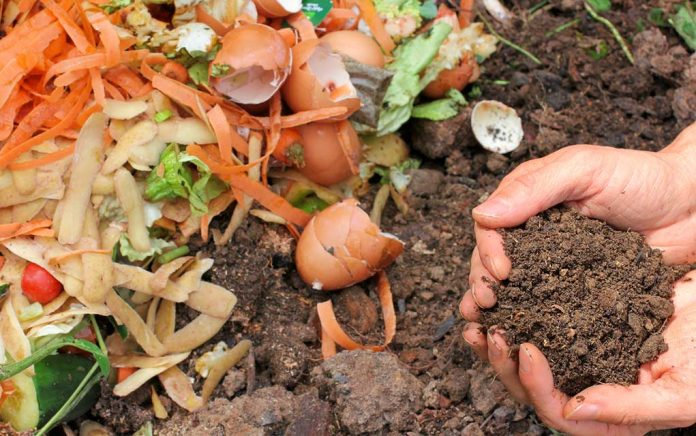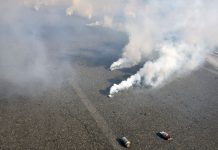(SurvivalDaily.com) – Learning how to properly compost can seriously help your garden, especially in a SHTF scenario. Chances are if SHTF, you’re not likely to be able to just run to a box store and find fertilizer. Instead, you’ll have to make your own. This is where composting plays a big part in your survival garden.
When composting you have brown items, green items, and water. For every green item you place into the compost pile, you need to add four brown items. This gives you the ideal ratio to make what is known as “Black Gold” soil. Each item serves a purpose, with brown items producing carbon, and green items producing nitrogen. Both of these elements are crucial to a garden. The water is used to add moisture when needed. Heat also plays a role in how long it takes for the items to break down.
The Good, The Bad, and The Ugly
Now there are, of course, certain green and brown items that are better and worse for your compost. Adding too much of one category can cause the compost to stink, and/or take longer to break down. Let’s start off with the good items first; these are things that will help your compost more than anything.
- Paper products such as newspapers, paper, or even cardboard. These brown items work best when shredded or ripped up.
- Kitchen scraps, green waste in particular, such as lettuce, spinach, and herbs. These green items provide a good source of nitrogen. Cutting them up aids in decomposition, but is not required.
- Coffee grounds and filters are green items that need to be used before recycling and putting them into the compost. Fresh coffee is too acidic; the used product creates a neutral base with a great nitrogen boost.
- Hair and nails may seem gross, but they are quite beneficial. These green items are a major source of nitrogen.
- Yard waste such as grass clippings, leaves, plants, and small sticks are great sources of nitrogen, and provide much-needed airflow. Sticks and leaves are brown items and provide carbon for your compost.
- Ash, wood ash in particular, provides a potassium-rich alkaline base, but should only be used in moderation.
Moving on to the “bad” items. These do provide some benefit to your compost, but also may harm its effectiveness.
- Lint if dry can be used in your compost, but should not be used if it does not come from natural articles.
- Latex does contain other items aside from rubber, but again should only be used if it’s all-natural.
- Citrus peels are highly acidic and may kill beneficial microorganisms.
- Onions are also very acidic, and they also take a very long time to break down.
- Breads and pastas will likely attract pests, such as raccoons and possums.
Wood ash and sawdust from treated sources are harmful to your compost pile and should not be included. That being said it’s time to name the “ugly” items that will ruin your compost.
- Chemicals have no place in your compost, as they may bring about harmful effects. This includes pesticide-treated plants.
- Bones, specifically whole bones, will not break down and provide no benefit to your pile.
- Meat will bring about a horrendous smell, and attract unwanted pests.
- Human feces poses a serious health concern, and should only be used with an organic diet, especially if not dried. This is also true for dog and cat feces, as they may contain parasites harmful to plants planted in the compost soil.
- Dairy products will spoil, giving off a terrible aroma and will also attract pests.
Building Your Compost
Creating your compost is simple. Choose a bin, barrel, or even just a pile. If you’re feeling froggy you could even use a combination of the three. Next, you’ll need to find a location for your compost, a dry shady location close to a water source is ideal. You can then start adding material as it’s gathered, making sure you break big pieces into smaller ones. This helps the decomposition process, and makes it faster.
Keeping the compost pile damp helps attract worms, which will aid in the decomposition. Be sure to turn or mix your pile, ideally once a week, as this keeps a good air intake going and will keep the pile warm. The warmer your pile is, the faster it will decompose, and the sooner you’ll be able to use it. You don’t need to cover your compost, though it helps keep it warm and damp. Once it’s broken down into a dark rich colored material, your compost is ready to be used. Note that if done properly, your compost should not smell, or attract pests.
Learning how to compost properly can bring multiple benefits to your home for several reasons, especially if SHTF. You’ll be able to reduce waste, and provide your own fertilizer, helping your garden grow while reducing concerns about waste disposal. It also makes you more aware of what you buy, what it’s made of, and even how it’s packaged. After you’ve harvested your crops, you can repeat the cycle with unused plant waste and potentially eventually become completely self-sufficient.
~Copyright 2021, SurvivalDaily.com

















